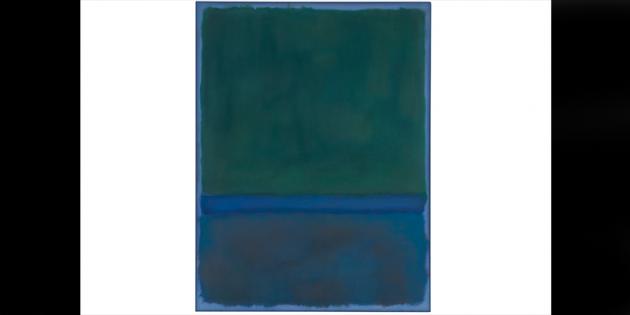Christie’s Evening Sale of Post-War & Contemporary Art on May 10, is lead by Mark Rothko’s important 1957 canvas, No. 17. It carries an estimate: $30-40million. With its vibrant, verdant hues, No. 17 is emblematic of the experiential nature of Rothko’s art—a manifestation of what one critic called the “immediate radiance” of the paintings from this period of the artist’s career. One of the artist’s rare “blue” canvases, this work belongs to a select group that marked the culmination of a short period during which he executed a number of brightly hued works and just a few months before he embarked on a series of paintings that have become widely regarded as the pinnacle of his career, the Seagram Murals (Tate Gallery, London).
This painting was featured in the vital 1961-1963 Rothko retrospective, which traveled across Europe championing the cause of Abstract Expressionism and confirming Rothko’s status as one of its vanguards. The retrospective’s first stop in Europe was the seminal exhibition at The Whitechapel Art Gallery in London, which was where much of the British Public first encountered Rothko’s work.
Following the retrospective, No. 17 was acquired by an important private Italian collection, where it remained unseen by the public for the next several decades. However, it reemerged into the public eye in 2001 when it appeared as a central part of a major exhibition mounted by the Fondation Beyeler. It was there that the curator described No. 17 as “a fine example of…his virtuoso paint handling…” Following the exhibition, the painting was acquired by a private collection, where it has remained until today.
Brett Gorvy, International Head of Post-War and Contemporary Art, remarked: “No. 17, is a strikingly beautiful canvas that comes with an exhibition history that places it within the canon of Rothko’s most important paintings of the late 1950’s. We are particularly pleased to be presenting this work to the marketplace at a time when there is such tremendous demand for examples by Rothko of this remarkable quality. With its vibrant, enveloping surface, and its freshness to the auction market, we are confident that No. 17 will appeal to a broad global audience.”
No. 17 is being sold on the heels of the tremendously successful sale of Rothko’s 1958 painting, No. 10, which realized $81,925,000 against a high estimate of $60 million at Christie’s New York, in May 2015. No. 10’s strength at auction demonstrated the tremendous demand for works of this quality by Rothko in the global marketplace, which continues to exist in full force today.
Produced at the dawn of his mature period, and just a short time before he embarked on what would become his magnum opus, the Seagram Murals, this painting encapsulates all of the drama and psychological intensity of an artist who became one of the most celebrated and influential artists of the twentieth century.
Sandwiched between both these blocks is a strip of high-keyed azure blue, the active edges of this thin strip increasing their impact by bleeding into the neighboring areas with intoxicating results. Rothko always insisted that it was here, where the edges of his painterly passages meet, that the true essence of his paintings could be witnessed.
This painting encapsulates all of the drama and psychological intensity of an artist who became one of the most celebrated and influential artists of the twentieth century.
No. 17 was exhibited in the retrospective of Rothko’s work that was organized by the International Council of the Museum of Modern Art, New York. The retrospective travelled widely throughout Europe from 1961-1963. The first stop was the seminal 1961 exhibition at the Whitechapel Art Gallery in London (one of the artist’s first solo shows in Europe). This was the exhibition that introduced Rothko to the British Public.
Following Whitechapel, the retrospective traveled to Amsterdam, Brussels, Basel, Rome before finishing at the Musée d’Art Moderne de la Ville de Paris in January 1963. Visitors to the exhibition described their reaction to the artist’s paintings as “Shocked… Spellbound… Transformed”
A current curator at the Whitechapel, Nayai Yiakoumaki, called this exhibition one of the artist’s most significant. “This exhibition is very important because it introduced his work to the British public for the first time, in such a large volume and a public gallery… [From] this exhibition on, the art world was captivated by Rothko and subsequently, [Tate Director] Norman Reid, approached the artist to discuss a purchase of works…culminating with the substantial donation of eight of the Seagram Murals to the Tate in 1970” (N. Yiakoumaki, ibid.).
Following Rothko’s European retrospective, No. 17 spent several decades out of the public realm in a private European collection before making a triumphal appearance in 2001 when it was publicly exhibited for the first time in over 30 years.
In 2001, No. 17 (also in the past known as Green on Blue on Blue) appeared at a major exhibition mounted by the Fondation Beyeler in 2001. During its time out of public view, the painting was an important part of a private Italian collection and its exhibition in Basel was the first time the work had been on public display for nearly thirty years.

